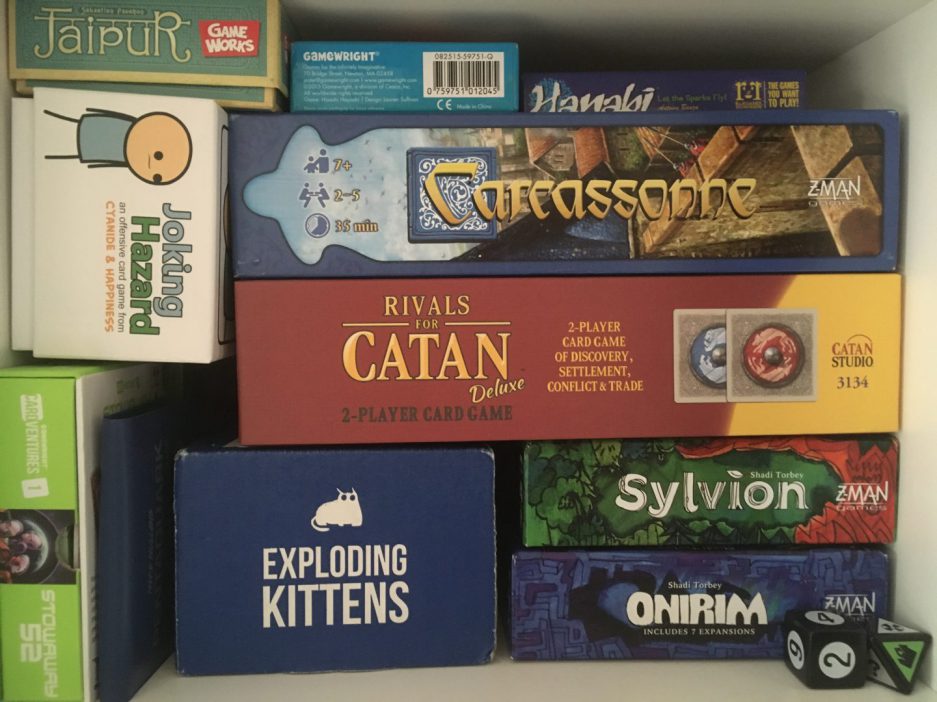Istanbul is one of my favorite board games. In it, you are a merchant trying to make it through the grand markets and bazaars of Istanbul by pushing around your wheelbarrow, picking up and selling goods, and collecting rubies. Whichever merchant reaches 5 rubies (6 in a 2-player game) wins the game.
What I like the most about it is that even though there are some interactions between players, it is mostly parallel play. Therefore, it is not super competitive, there aren’t much in-your-face, take-that kind of mechanics. And I think this allows for a good solo variant.
So here is the setting: let’s have an AI character that moves according to a bunch of rules: I’ll call him “Travelling Merchant”. The point of the solo variant is to defeat the Travelling Merchant. He can travel across the board easily and isn’t bound by the rules of moving one or two spots from his current spot. That’s why he’s called Travelling Merchant.
So the solo variant is actually a typical two-player setting. Here are the rules that the AI follows, prioritized from top to bottom:
- Whenever he has 7 liras, he immediately goes to the Wainwright and collects a Wheelbarrow extension in the next turn.
- Whenever he has enough resources, he immediately goes to the Mosque and collects the tile that the resource corresponds to, in the next turn.
- Whenever he has enough resources, he immediately goes to the Sultan’s Palace and collects a ruby in the next turn.
- Whenever he has enough liras, he immediately goes to the Gemstone Dealer and collects a ruby in the next turn.
- If he can’t do any of these, he moves by rolling the dice. The tiles are organized by the big, red numbers and he moves to the number that’s rolled with one exception: rolling 7 makes him move to one of the warehouses instead of the Fountain. Whichever resource he has the least, he moves to that one. If some of the number of resources are equal, prioritize the resources from top to bottom as seen in your Wheelbarrow.
- He moves to the Fountain when he runs out of Assistants. He leaves an assistant wherever he goes, just like you.
- He knows the owner of the Tea House, so he just rolls the dice and collects the number of liras that the dice shows.
- He also knows the owner of the Caravansaray, so he just gets two bonus cards. He either uses them immediately (like 5 lira card or get a good card), or whenever he can (like do the Post Office action twice card).
- At the Small/Large Market, he sells as many of the resources as he can.
- If he’s trying to go somewhere and there’s another merchant there that he has to pay, he goes to the police station and sends his family member instead, if he can.
- He always pays to the Governor and the Smuggler 2 liras to keep a card or a good, if he can. Similar to the warehouse, he always prioritizes the goods that he has the least when using Smuggler. If he can’t pay them, he discards the cards that he can’t use immediately or exchanges the good that he has the most with the good that he has the least, if the number of goods are all equal, he doesn’t use the Smuggler.
- For the mosque tiles, the use of red and blue tiles are obvious. For the green tile, he always uses it to get the resource he has the least, if he can (if he has 2 liras). Yellow tile is kind of useless, so you can either assume he only gets it to collect the mosque ruby, or you can still use it, if it seems like it will benefit the Travelling Merchant (when he needs to go somewhere immediately the next turn but he runs out of assistants).
One note I have is that the Caravansaray is kind of tricky. Because of the probabilities he’ll roll 6 a lot, so he’ll go to Caravansaray a lot. Some of the cards are useless to him (like don’t move or move 3-4 tiles cards), but taking two cards is supposed to balance it out. However, if it seems like this Caravansaray mechanism is not working, the 6 roll can be assigned to other tiles. Similar to the assignment of 7 to warehouses, 6 can be assigned to markets. He may go to the market where he can sell the most goods.
So this is the general idea. See if you can beat the Travelling Merchant! If you have any questions, do let me know in the comments!

